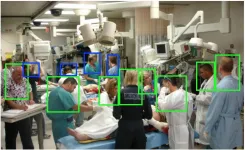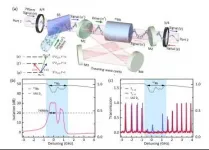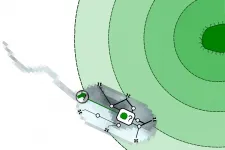Making the shift from blue to red for better LEDs
2021-05-10
(Press-News.org) A new micro-light-emitting diode (micro-LED) developed at KAUST can efficiently emit pure red light and may help in the quest to develop full-color displays based on just a single semiconductor.
Micro-LEDs are a promising technology for the next generation of displays. They have the advantage of being energy efficient and very small. But each LED can only emit light over a narrow range of colors. A clever solution is to create devices that combine many different LEDs, each emitting a different color. Full-color micro-displays can be created by combining red, green and blue (RGB) micro-LEDs. Now, a KAUST team of Zhe Zhuang, Daisuke Iida and Kazuhiro Ohkawa have worked to develop a more efficient red LED.
The emission color of an LED is determined by the material properties of the semiconductor. For example, nitride semiconductors can be used to make blue and green micro-LEDs, whereas phosphide semiconductors are used for red light. But combining different semiconductors in this way makes construction of RGB micro-LEDs more difficult and expensive. Besides, the efficiency of phosphide micro-LEDs reduces significantly with shrinking chip size.
Red-light emitting indium gallium nitride can be created by increasing the materials' indium content. But this tends to lower the efficiency of the resulting LED because there is a mismatch between the separation of atoms in the GaN and InGaN, which causes atomic-level imperfections. Moreover, damage to the sidewalls of an InGaN micro-LED induced during the fabrication process makes the new device less efficient. "But we have a chemical treatment to remove the damage and retain the high crystal quality of the InGaN and GaN sidewall interface," explains Zhuang.
Zhang's team created and characterized a series of square devices with a side-length of 98 or 47 micrometers. Their 47-micrometer-long devices emitting light at a peak wavelength of 626 nanometers were shown to have an external quantum efficiency -- the number of photons emitted from the LED per electron injected into the device -- of up to around 0.87 percent. Also, the color purity of the red micro-LED is optimum because it is very close to the primary red color defined by the industrial standard known as Rec. 2020.
"The next step is to increase the efficiency of the red micro-LED with even smaller chip sizes, maybe below 20 micrometers," says Zhuang. "Then we hope to integrate RGB nitride-based LEDs for full-color displays."
INFORMATION:
ELSE PRESS RELEASES FROM THIS DATE:
2021-05-10
SAN FRANCISCO, CA (May 10, 2021) -- The Gulf of Guinea islands harbor an abundance of species found nowhere else on Earth. But for over 100 years, scientists have wondered whether or not a population of limbless, burrowing amphibians--known as caecilians--found on one of the islands is a single or multiple species. Now, a team of researchers from the California Academy of Sciences and the Smithsonian National Museum of Natural History has contributed the strongest evidence to date that there is not one, but two different species of caecilians on São Tomé ...
2021-05-10
Computer scientists at the University of California San Diego have developed a more accurate navigation system that will allow robots to better negotiate busy clinical environments in general and emergency departments more specifically. The researchers have also developed a dataset of open source videos to help train robotic navigation systems in the future.
The team, led by Professor Laurel Riek and Ph.D. student Angelique Taylor, detail their findings in a paper for the International Conference on Robotics and Automation taking place May 30 to June 5 in Xi'an, China.
The project stemmed from conversations with clinicians over several years. The consensus was that robots would best help physicians, nurses and staff ...
2021-05-10
An international team led by researchers from the Xinjiang Institute of Ecology and Geography (XIEG) of the Chinese Academy of Sciences and the University of Geneva has found that flash floods may triple across the Earth's "Third Pole" in response to ongoing climate change.
Their findings were published in Nature Climate Change on May 6.
The Hindu Kush-Himalaya, Tibetan Plateau and surrounding mountain ranges are widely known as the "Third Pole" of the Earth. It contains the largest number of glaciers outside the polar regions.
Due to global warming, the widespread and accelerated melting of glaciers over ...
2021-05-10
Remote quantum distribution on the ground is limited because of the loss of photon in optical fibers. One solution for remote quantum communication lies in quantum memories: photons are stored in the long-lived quantum memory (quantum flash drive) and then quantum information is transmitted by the transportation of the quantum memory. Given the speed of aircrafts and high-speed trains, it is critical to increase the storage time of the quantum memories to the order of hours.
In a new study published in Nature Communications, a research team led by Prof. LI Chuanfeng and Prof. ZHOU Zongquan from University of Science and Technology of China (USTC) extended the storage time of the optical memories to over one hour. It broke the record of one minute achieved by German researchers in 2013, ...
2021-05-10
Chinese researchers achieved 51.5dB nonreciprocal isolation in the atomic ensemble, which is the highest isolation ratio in the non-magnetic nonreciprocal field. They discussed the quantum noise problem in nonreciprocal devices for the first time.
The result was published on Nature Communications on April 22, 2021.
Nonreciprocity is an important basic concept in the optical field. The isolators and circulators derived from it are all indispensable components in the optical path. Faraday isolator based on circular birefringence of magneto-optical effect is widely used because of its easy construction, high isolation and low loss.
However, in the integrated optical path, the traditional faraday isolator is subject to various limitations. ...
2021-05-10
COLUMBUS, Ohio - Watching meaningful films - those that we find moving and poignant - can make us feel more prepared to deal with life's challenges and want to be a better person, a new study found.
The findings point to one reason why people may choose to see movies that make them sad as well as happy and that may explore difficult subjects that aren't always uplifting.
Researchers found that when people recalled watching meaningful films like The Shawshank Redemption and Up, they reported a variety of positive reactions, such as being better able to accept the human condition and make sense of problems in life.
Those positive experiences were less likely to be reported when people thought about watching Hollywood fare like The Big Lebowski or Catch Me ...
2021-05-10
TAMPA, Fla. (May 10, 2021) -- Blocking the fat-busting enzyme lipoxygenase with a synthetic inhibitor throws the immune system's innate inflammatory response out of whack, compromising cardiac repair during acute heart failure, USF Health researchers found.
Their new preclinical study was published April 13 in Biomedicine & Pharmacotherapy.
Acute heart failure - triggered by a heart attack, severely irregular heartbeats, or other causes -- occurs suddenly when the heart cannot pump enough blood to meet the body's demands.
Following a heart attack or any cardiac injury, signals to immune cells called leukocytes ...
2021-05-10
WASHINGTON - A neurologic pathway by which non-damaging but high frequency brain impact blunts normal brain function and causes long-term problems with learning and memory has been identified. The finding suggests that tailored drug therapy can be designed and developed to reactivate and normalize cognitive function, say neuroscientists at Georgetown University Medical Center.
The investigators, working with collaborators at the National Institutes of Health, had previously found that infrequent mild head impacts did not have an effect on learning and memory, but in their new study, reported May 10 in Nature Communications (DOI: 10.1038/s41467-021-22744-6), the investigators found that when the frequency of these ...
2021-05-10
How is it possible to move in the desired direction without a brain or nervous system? Single-celled organisms apparently manage this feat without any problems: for example, they can swim towards food with the help of small flagellar tails.
How these extremely simply built creatures manage to do this was not entirely clear until now. However, a research team at TU Wien (Vienna) has now been able to simulate this process on the computer: They calculated the physical interaction between a very simple model organism and its environment. This environment is a liquid with a non-uniform ...
2021-05-10
The morphological compatibility between flowers and insects was given in the famous textbook example of Darwin's orchids and hawkmoths. As in this example, many studies have shown that geographical variations in flower size match the size of insects in each region. In other words, studies have shown "flower-sized regional adaptation" in which large flowers evolve in areas pollinated by large insects and small flowers evolve in areas pollinated by small insects.
However, when examining the genetic similarity between populations, are plants in each region more similar, or are plants with large ...
LAST 30 PRESS RELEASES:
[Press-News.org] Making the shift from blue to red for better LEDs







